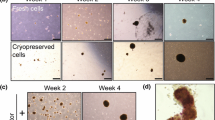Sertoli-like cells is a cell population in the testes of adult mice capable of growth in culture and expressing many genes typical of Sertoli cells and supporting the development of germ cells in the gonad. A technique of co-culturing of Sertoli-like cells with spermatogonial cells was proposed that allows maintaining the growth and viability of germ cells and inducing their differentiation. This technique can provide the basis for obtaining fully differentiated germ cells in culture through using Sertoli-like cells as the supporting somatic cells.
Similar content being viewed by others
References
Kulibin AYu, Malolina EA. A combination of small molecular inhibitors YAC increases expression levels of DMRT1 in the culture of Sertoli cells from the transitional zone of mouse testis. Geny Kletki. 2018;13(3):75-81. Russian.
Malolina EA, Kulibin AY. Rete testis and the adjacent seminiferous tubules during postembryonic development in mice. Rus. J. Devel. Biol. 2017;48(6):385-392.
Falciatori I, Lillard-Wetherell K, Wu Z, Hamra FK, Garbers DL. Deriving mouse spermatogonial stem cell lines. Methods Mol. Biol. 2008;450:181-192.
Kubota H, Avarbock MR, Brinster RL. Growth factors essential for self-renewal and expansion of mouse spermatogonial stem cells. Proc. Natl Acad. Sci. USA. 2004;101(47):16,489-16,494.
Kulibin AY, Malolina EA. Only a small population of adult Sertoli cells actively proliferates in culture. Reproduction. 2016;152(4):271-281.
Matson CK, Murphy MW, Sarver AL, Griswold MD, Bardwell VJ, Zarkower D. DMRT1 prevents female reprogramming in the postnatal mammalian testis. Nature. 2011;476:101-104.
Medrano JV, Vilanova-Pérez T, Fornés-Ferrer V, Navarro-Gomezlechon A, Martínez-Triguero ML, García S, Gómez-Chacón J, Povo I, Pellicer A, Andrés MM, Novella-Maestre E. Influence of temperature, serum, and gonadotropin supplementation in short- and long-term organotypic culture of human immature testicular tissue. Fertil. Steril. 2018;110(6):1045-1057.
Meng X, Lindahl M, Hyvönen ME, Parvinen M, de Rooij DG, Hess MW, Raatikainen-Ahokas A, Sainio K, Rauvala H, Lakso M, Pichel JG, Westphal H, Saarma M, Sariola H. Regulation of cell fate decision of undifferentiated spermatogonia by GDNF. Science. 2000;287:1489-1493.
Muratori M, Baldi E. Effects of FSH on sperm DNA fragmentation: review of clinical studies and possible mechanisms of action. Front. Endocrinol. (Lausanne). 2018;9. ID 734. doi: https://doi.org/10.3389/fendo.2018.00734
Raymond CS, Murphy MW, O’Sullivan MG, Bardwell VJ, Zarkower D. Dmrt1, a gene related to worm and fly sexual regulators, is required for mammalian testis differentiation. Genes Dev. 2000;14(20):2587-2595.
Saitou M, Miyauchi H. Gametogenesis from pluripotent stem cells. Cell Stem Cell. 2016;18(6):721-735.
Sariola H, Immonen T. GDNF maintains mouse spermatogonial stem cells in vivo and in vitro. Methods Mol. Biol. 2008;450:127-135.
Sato T, Katagiri K, Kubota Y, Ogawa T. In vitro sperm production from mouse spermatogonial stem cell lines using an organ culture method. Nat. Protoc. 2013;8(11):2098-2104.
Sofikitis N, Pappas E, Kawatani A, Baltogiannis D, Loutradis D, Kanakas N, Giannakis D, Dimitriadis F, Tsoukanelis K, Georgiou I, Makrydimas G, Mio Y, Tarlatzis V, Melekos M, Miyagawa I. Efforts to create an artificial testis: culture systems of male germ cells under biochemical conditions resembling the seminiferous tubular biochemical environment. Hum. Reprod. Update. 2005;11(3):229-259.
Zarkower D. DMRT genes in vertebrate gametogenesis. Curr. Top Dev. Biol. 2013;102:327-356.
Zhang J, Hatakeyama J, Eto K, Abe S. Reconstruction of a seminiferous tubule-like structure in a 3 dimensional culture system of re-aggregated mouse neonatal testicular cells within a collagen matrix. Gen. Comp. Endocrinol. 2014;205:121-132.
Zhou Q, Wang M, Yuan Y, Wang X, Fu R, Wan H, Xie M, Liu M, Guo X, Zheng Y, Feng G, Shi Q, Zhao X. Y, Sha J, Zhou Q. Complete meiosis from embryonic stem cell-derived germ cells in vitro. Cell Stem Cell. 2016;18(3):330-340.
Author information
Authors and Affiliations
Corresponding author
Additional information
Translated from Kletochnye Tekhnologii v Biologii i Meditsine, No. 2, pp. 133-138, June, 2019
Rights and permissions
About this article
Cite this article
Malolina, E.A., Kulibin, A.Y. Creation of a Model of Co-Culturing of Sertoli-Like Mouse Cells with Spermatogonial Cells. Bull Exp Biol Med 167, 584–589 (2019). https://doi.org/10.1007/s10517-019-04576-z
Received:
Published:
Issue Date:
DOI: https://doi.org/10.1007/s10517-019-04576-z




